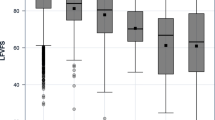Abstract
Purpose
To investigate the relationship between methods used to evaluate the visual field (VF) and vision-related quality of life (VRQOL) in Japanese patients.
Methods
We evaluated the VRQOL of 50 patients using the National Eye Institute Visual Function Questionnaire 25 (VFQ-25). Patients meeting the following criteria were assessed: (1) a Goldmann perimetry (GP) test conducted within 3 months of the initial visit; (2) best-corrected decimal visual acuity (VA) of the better eye when VRQOL was measured was less than 0.3 but more than 0.05. The VF was estimated based on a composite measure of the V-4e isopters of both eyes, as measured by GP. We calculated the VF using the American Medical Association (AMA) score, the Esterman disability score (EDS), the functional field score (FFS), the composite VF area calculated with area measurement software, and SR, an evaluation method based on solid angles. We then studied the relationships between the VFQ-25 score and the VF scores.
Results
Only EDS correlated significantly with the VFQ-25 score (r = 0.34, P = 0.02); AMA scoring did not correlate with the VFQ-25 score.
Conclusion
It is necessary to reexamine standard VF evaluation methods.
Similar content being viewed by others
References
Mangione CM, Lee PP, Pitts J, et al. Psychometric properties of the National Eye Institute Visual Function Questionnaire (NEI-VFQ). NEI-VFQ field test investigators. Arch Ophthalmol 1998;116:1496–1504.
Mangione CM, Lee PP, Gutierrez PR, Spritzer K, Berry S, Hays RD; National Eye Institute visual function questionnaire field test investigators. Development of the 25-item National Eye Institute Visual Function Questionnaire. Arch Ophthalmol 2001;119:1050–1058.
Cahill MT, Banks AD, Stinnett SS, Toth CA. Vision-related quality of life in patients with bilateral severe age-related macular degeneration. Ophthalmology 2005;112:152–158.
Varma R, Wu J, Chong K, Azen SP, Hays RD; Los Angeles Latino Eye Study Group. Impact of severity and bilaterality of visual impairment on health-related quality of life. Ophthalmology 2006;113:1846–1853.
Hahm BJ, Shin YW, Shim EJ, et al. Depression and the vision-related quality of life in patients with retinitis pigmentosa. Br J Ophthalmol 2008;92:650–654.
Rossi GC, Milano G, Tinelli C. The Italian version of the 25-item National Eye Institute Visual Function Questionnaire: translation, validity, and reliability. J Glaucoma 2003;12:213–220.
Nordmann JP, Viala M, Sullivan K, Arnould B, Berdeaux G. Psychometric validation of the National Eye Institute Visual Function Questionnaire-25 (NEI VFQ-25) French version: in a population of patients treated for ocular hypertension and glaucoma. Pharmacoeconomics 2004;22:197–206.
Suzukamo Y, Oshika T, Yuzawa M, et al. Psychometric properties of the 25-item National Eye Institute Visual Function Questionnaire (NEI VFQ-25), Japanese Version. Health Qual Life Outcomes 2005;3:65.
Ringsdorf L, McGwin G Jr, Owsley C. Visual field defects and vision-specific health-related quality of life in African Americans and whites with glaucoma. J Glaucoma 2006;15:414–418.
Jampel HD, Schwartz A, Pollack I, et al. Glaucoma patients’ assessment of their visual function and quality of life. J Glaucoma 2002;11:154–163.
Marron JA, Bailey IL. Visual factors and orientation-mobility performance. Am J Optom Physiol Opt 1982;59:413–426.
Faye EE. The effect of the eye condition on functional vision. In: Fare EE, editor. Clinical low vision. New York: Little, Brown; 1984. p. 171–196.
Sumi I, Shirato S, Matsumoto S, Araie M. The relationship between visual disability and visual field in patients with glaucoma. Ophthalmology 2003;110:332–339.
McKean-Cowdin R, Varma R, Wu J, Hays RD, Azen SP; Los Angeles Latino Eye Study Group. Severity of visual field loss and health-related quality of life. Am J Ophthalmol 2007;143:1013–1023.
Guides to the evaluation of permanent impairment: the visual system. JAMA 1958;168:475–485.
Esterman B. Grid for scoring visual field II. Perimeter. Arch Ophthalmol 1968;79:400–406.
Esterman B. Functional scoring of the binocular field. Ophthalmology 1982;89:1226–1234.
Colenbrander A, Lieberman MF, Schainholz DC. Preliminary implementation of the Functional Vision Score system on the Humphrey Field Analyzer. In Mills RP, editor. Proc Xth International Perimetric Society Meeting, Kyoto. Amsterdam, New York: Kugler Publications; 1993.
Cocchiarella L, Andersson GBJ. The visual system. In: Guides for the evaluation of permanent impairment. 5th edition. Chicago: American Medical Association; 2001.
Kamo J. How to calculate the area of the visual field in persons with Grade 5 visual handicap [in Japanese with English abstract]. Folia Ophthalmol Jpn 2005;56:595–598.
Baba H. Quantitative evaluation of the visual field measured by Goldmann perimetry as a solid angle [in Japanese with English abstract]. Nippon Ganka Gakkai Zasshi 1986;90:210–214.
Langelaan M, Wouters B, Moll AC, de Boer MR, van Rens GH. Functional field score: the effect of using a Goldmann V-4e isopter instead of a Goldmann III-4e isopter. Invest Ophthalmol Vis Sci 2006;47:1817–1823.
Takahashi G. Objective evaluation and normal values by age of quantitative kinetic perimetry [in Japanese with English abstract]. Tokyo Jikeikai Med J 1997;112:697–701.
Fujita K, Yasuda N, Nakamoto K, Fukuda T. The relationship between difficulty in daily living and binocular visual field in patients with glaucoma [in Japanese with English abstract]. J Jpn Ophthalmol Soc 2008;112:447–450.
Author information
Authors and Affiliations
Corresponding author
About this article
Cite this article
Yanagisawa, M., Kato, S., Kunimatsu, S. et al. Relationship between vision-related quality of life in Japanese patients and methods for evaluating visual field. Jpn J Ophthalmol 55, 132–137 (2011). https://doi.org/10.1007/s10384-010-0924-8
Received:
Accepted:
Published:
Issue Date:
DOI: https://doi.org/10.1007/s10384-010-0924-8




